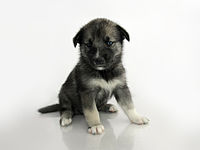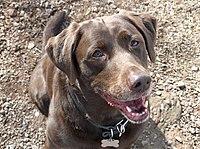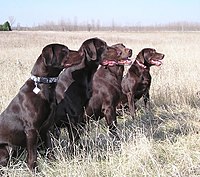 Image via Wikipedia
Image via Wikipedia
Labrador retriever owners are blessed with a breed that loves to learn. All training must enforce the idea that learning not only is fun but it will bring positive responses from the owner. Learning is not a game, but it need not be unpleasant either.
Training your Labrador retriever to be a mannerly adult is begun at birth, by its mother. Once the puppy arrives at the new owner's home, it has already been given some basic instructions on behavior - so don't be fooled into thinking it is too young to behave. A puppy is, of course, too young to teach formal commands, but early lessons in manners and on who is in charge can begin at once.
The Labrador retriever is a highly intelligent animal and a capable learner. It embodies many natural instincts and abilities that make this breed distinct among others of similar heritage. But at the core, a Labrador retriever is a dog - originally a pack animal. From earliest times, pack animals have exhibited a pattern of behavior that affects the process of training:
A pack animal assumes it is the boss until proved otherwise (the leader-of-the-pack syndrome). At birth, the dam assumes the leadership position and keeps her young in line. As the puppies begin to assert their independence, she will remind them of their place through low growls, a swat of the paw, or an occasional shake of the neck. Little else is necessary. She admonishes her young swiftly, fairly, consistently, and unemotionally, and they respect her position as leader. The wise owner follows the dam's example.
Consistency is vital. Should the dog misbehave, respond accordingly and appropriately. Do not let his "cute little antics" go uncorrected as this will undermine your leadership. Respond firmly but fairly, letting him know what is expected of him and what will not be tolerated. Brute force is not required and is counterproductive. When a dog is testing your authority, correct it in a manner a dog will understand - a firm vocal reprimand, a stem look, a shake of the neck. Little more should be necessary to make your displeasure clear if you are carrying out the corrections authoritatively. Be sure never to whine, nag, plead, or preach at the dog, as these are clearly not the actions of a leader and the dog will not feel compelled to obey.
![Reblog this post [with Zemanta]](http://img.zemanta.com/reblog_e.png?x-id=22fdc885-afd5-4a8c-a2f7-df66871d9826)

![Reblog this post [with Zemanta]](http://img.zemanta.com/reblog_e.png?x-id=79c331cd-76ec-4309-bc14-98d20af7961b)

![Reblog this post [with Zemanta]](http://img.zemanta.com/reblog_e.png?x-id=45160a9e-2154-4ca5-8fbd-65b6ba6bc165)

![Reblog this post [with Zemanta]](http://img.zemanta.com/reblog_e.png?x-id=b960dcba-d227-4f62-bc64-c9ce65f7905e)

![Reblog this post [with Zemanta]](http://img.zemanta.com/reblog_e.png?x-id=f198a631-3772-431c-84fd-17942e0e65d5)

![Reblog this post [with Zemanta]](http://img.zemanta.com/reblog_e.png?x-id=1923e713-a49d-45f6-8847-628775bea5f0)

![Reblog this post [with Zemanta]](http://img.zemanta.com/reblog_e.png?x-id=04082469-d932-4914-a904-6da756d66677)